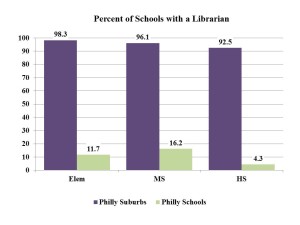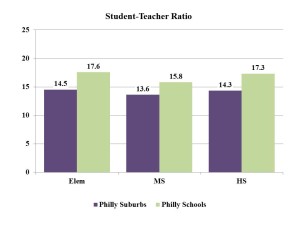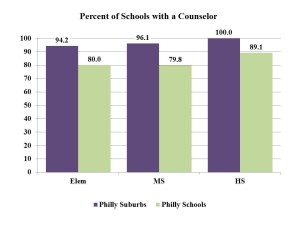The Commonwealth has long had an inequitable school finance “system” that allows for students in wealthy districts to have greater access to resources and opportunities than students in poor districts. This has been well-documented by Dr. Bruce Baker (see here, here, here, and here, among others). In addition, the Pennsylvania Budget and Policy Center recently released their analysis of SB 1073 and found that even with the progressive changes included in the bill, the Commonwealth would still inequitably fund Philly and other poor districts (PennPBC Report on SB 1073). Moreover, even with the increased funding for districts like Philly, the districts would have great difficulty in targeting those funds to the poorest schools within the districts (see explanation).
So, using data released by the state through the School Performance Profile website and PA education employment records, I decided to examine some issues regarding access to non-teaching educators and to advanced coursework in high schools.
In the tables and graphs below, I compare schools in the Philadelphia School District to schools in the suburbs surrounding Philly. All of the suburban districts are in the top 20% of all wealthiest districts in the state. In fact, many of the districts are among the wealthiest in the entire state.
Below, I examine access to non-teacher educators such as nurses, mental health specialists, counselors, and librarians. Existing research generally finds that access to such professionals–especially at the school level–is associated with improved student socio-emotional and academic outcomes. In a system designed to provide resources to students most in need of them, we would see students in Philly with greater (or at least equal) access to these professionals. Yet, as shown in a series of graphs below, we see the opposite.
ACCESS TO EDUCATION PROFESSIONALS
In the first graph, we see that a greater percentage of suburban schools at all three school levels (elementary schools, middle schools, and high schools) have at least a part-time nurse as compared to Philly schools. The differences are at least 10 percentage points at each level.
 In the second graph, we see that a greater percentage of suburban schools have a mental health specialist at the school than Philly schools. Only about 50% of Philly schools have at least one such specialist as compared to around 70% of suburban elementary and middle schools and 85% of suburban high schools.
In the second graph, we see that a greater percentage of suburban schools have a mental health specialist at the school than Philly schools. Only about 50% of Philly schools have at least one such specialist as compared to around 70% of suburban elementary and middle schools and 85% of suburban high schools.
 While not pictured, a greater percentage of suburban schools have a social worker employed at the school. At the high school level, 10% of suburban schools have a social worker as compared to just 2.2% of Philly schools.
While not pictured, a greater percentage of suburban schools have a social worker employed at the school. At the high school level, 10% of suburban schools have a social worker as compared to just 2.2% of Philly schools.
Thus, Philadelphia students have less access to nurses, mental health specialists, and social workers than their peers in affluent suburban districts even though Philly students arguably have a much greater need for the services provided by such professionals. This surely impacts the socio-emotional well-being of Philly students. Research shows that not addressing such needs of students has a negative impact on school climate and student outcomes.
Students in Philly also have less access to other important professionals such as counselors. Counselors are important members of the school team because they assist in the socio-emotional support of students and they also assist students in making important academic decisions. Moreover, research has consistently shown that high school counselors are key gatekeepers to enrolling in post-secondary institutions of education. One aspect of counselors assisting students well is working with fewer students. Experts recommend that counselors have no more than 250 students. Even this may be too many students when students have a great deal of needs that don’t get met elsewhere. In short, having access to a counselor can improve both the socio-emotional and academic outcomes of students.
The graph below shows that a greater percentage of suburban schools at all three levels. The differences are at least 10 percentage points, with the largest difference at the middle school level (16 percentage points).
Perhaps more telling–especially at the high school level–is the differences in the percentage of schools with a student-counselor ration of 250 to 1 or less. As shown below, most elementary and middle schools do not meet this recommendation, regardless of whether the schools are in Philly or in Philly suburbs. At the high school level–where counselors are critical to getting students into post-secondary institutions of education–almost 63% of suburban schools meet the recommended student-counselor ratio as compared to only about 11% of Philly schools.
 Suburban students are already more likely than Philly students to have parents that know how to navigate the system to get their kids enrolled in college, thus rely less on counselors for assistance (I’m not arguing suburban students don’t need good counselors–they do!). Philly students likely rely on counselors to access post-secondary education options to a much greater degree than their suburban peers, yet have less access to counselors, primarily because of more students per counselor. In fact, the average Philly counselor is responsible for about 530 students–more than double the 245 students for suburban counselors.
Suburban students are already more likely than Philly students to have parents that know how to navigate the system to get their kids enrolled in college, thus rely less on counselors for assistance (I’m not arguing suburban students don’t need good counselors–they do!). Philly students likely rely on counselors to access post-secondary education options to a much greater degree than their suburban peers, yet have less access to counselors, primarily because of more students per counselor. In fact, the average Philly counselor is responsible for about 530 students–more than double the 245 students for suburban counselors.
Finally, let’s look at access to librarians. As shown below, almost none of the Philly schools have a librarian–either part-time or full-time. I’ve met people that think librarians simply put books on the shelves. Librarians do far more than simply shelving books. They order books appropriate for their students, teach students how to use technology in conducting research, how to conduct research studies for class papers, and improve student literacy skills. Indeed, librarians have been shown to increase student academic outcomes (see here).
 Moreover, Philly students are less likely to have access to books at home, thus rely on librarians and libraries to a greater degree than their suburban counterparts. Yet, with the shortfall in state funding, the Philly district simply cannot afford to employ librarians.
Moreover, Philly students are less likely to have access to books at home, thus rely on librarians and libraries to a greater degree than their suburban counterparts. Yet, with the shortfall in state funding, the Philly district simply cannot afford to employ librarians.
Finally, students benefit from having smaller classes, especially students with greater academic needs such as the ones in Philly (see here for an overview of the importance of class size). Indeed, peruse the web sites for elite private schools in Philly and one of the primary selling points is small class sizes. Why? Because wealthy parents know that their children will benefit from the individual attention. Yet, as we see below, suburban students have smaller student-teacher ratios than Philly students. While student-teacher ratio is only a proxy for class size, the data suggests suburban students have smaller classes than Philly students. Even though Philly students are more in need of and would benefit to a greater degree from smaller classes.
 Why the difference in access? Primarily because the state grossly under funds the Philly school system and it has for decades. In fact, even with a new budget and additional funding, the Penn PBC report–which everyone should read here–shows that Philly will continue to be dramatically underfunded by the state.
Why the difference in access? Primarily because the state grossly under funds the Philly school system and it has for decades. In fact, even with a new budget and additional funding, the Penn PBC report–which everyone should read here–shows that Philly will continue to be dramatically underfunded by the state.
Thus, even if we do get a new budget that infuses new money into the system, we need a new and improved school finance system that is based on the amount of money each district needs to reasonably expect the district to meet the state performance expectations. Clearly we aren’t there yet and the kids of Philly (and elsewhere) continue to suffer for it.
